US Defense Authorisation and the Arctic
Recently the United States’ annual defense policy bill cleared Congress with a provision allowing up to six icebreakers (see “U.S. Congress authorizes six icebreakers in Pentagon bill“). Inclusion of six icebreakers in this year’s US National Defense Authorization Act (HR-5511 or FY19 NDAA) is a major step forward but it must first “arm wrestle” (Alaskan Senator Murkowski’s words) the House of Representatives which, only last week, specifically removed icebreaker funding in the Homeland Security Appropriations bill. Despite broad bi-partisan Congressional support, US presidential approval of FY19 NDAA is not yet “a done deal”.
While the RUSI community tends to focus on “hard security,” sight must not be lost that US icebreaker procurement is heavily driven by fiscal interests in the American Arctic (i.e., Alaska coasts). Despite Shell Oil’s decision to withdraw from its Chukchi Sea offshore projects, maritime activity is booming in Alaska. The IMO is reviewing a joint US/Russian submission to create the Arctic’s first Vessel Traffic Management (VTM) scheme to guide Bering Strait shipping; a transshipment container hub port is envisioned for Dutch Harbor and/or Adak; the Alaskan “Deep Draft” harbour study is again underway after a four year interruption, with Nome lecturing Congress about how to diversify the state’s economy; and geo-strategic circles (including those in China) are engaged in heavy discussions on the need to break the Russian icebreaker monopoly. While not specifically defence issues, they reach deep into the maritime security domain. US icebreaker supporters (e.g., Senator Sullivan R-AK) have emphasized concern that the US icebreaker shortage is hurting US strategic business interests as much as military considerations, and it played well within both Congress and the House.
Other Arctic items of interest in the FY19 NDAA include: (full text)
Arctic Strategy: An updated Arctic Strategy is required within 180 days, describing roles and missions of each military service in the Arctic region in the context of joint operations to support the Arctic strategy and a description of near-term and long-term training, capability, and resource gaps that must be addressed to fully execute each mission described in the Arctic strategy against an increasing threat environment.
Cold Weather Training: DoD must analyze current and future cold weather training requirements for all four services and look for opportunities to expand cold weather training, including analysis of potential cold weather amphibious landing locations for live fire exercises.
Alaska MILCON: HR-5511 authorizes $286.8 million for Alaska military construction.
Innovative Readiness Training: Funding in provided for future local reserve training projects, including Operation Arctic Care, which provides roving medical and dental care to rural Alaska villages.
Spaceports Study: A provision to require the Secretary of Defense to conduct a study on space launch locations, including existing and new locations, for certain orbits in support of national security space priorities. Specific mention of the existing FAA-licensed Pacific Spaceport Complex-Alaska on Kodiak Island highlights and encourages expansion of its usage for both testing and operational roles.
Arctic Search and Rescue: DoD is encouraged to provide additional resources to the Alaska National Guard’s search and rescue package that enables large-scale Arctic mass-casualty event response and to expand Arctic search and rescue capabilities.
SUSV Replacement Report: DoD must conduct a DoD-wide operational needs review and to consider granting rapid acquisition authorities to procure a replacement to the Small Unit Support Vehicle (SUSV).
Arctic Missile Defence: Not unexpectedly, both ballistic and conventional missile defence received extensive mention (and funding). The Act calls for a continuation of US homeland layered defence models with more research for improving intercept capability, which will likely benefit assets already positioned in Alaska with probable application to other US Arctic facilities worldwide.
OCONUS Medical Hub: DoD is directed to create a new healthcare delivery framework based on five health-readiness regions – three in the contiguous US (CONUS) and two outside (OCONUS) – with each region containing a hub facility provide complex, specialized medical services. Language inserted by Senator Sullivan specifies that, when deciding the OCONUS hub location, DoD should focus on meeting the needs of existing and future contingency and operational plans, which favours Alaska’s strategic location.
The US position on the Arctic appears to be toughening. Whereas the Obama administration treated the Arctic as critical but not urgent, the new FY budget suggests a sense of urgency is now being applied.




